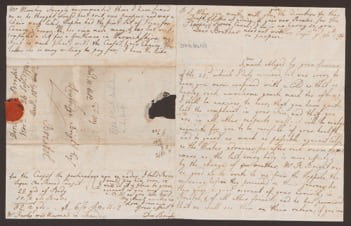
Textual personalities: the letters of Mary and Dorothy Bright
Francesca Kavanagh (PhD Candidate in English and Literature in the University of Melbourne School of Culture and Communications)
The Bright family papers comprise one of the most significant collections of artefacts pertaining to Jamaican and English trade in the mid- to late-eighteenth century held in Australia. Housed in the University of Melbourne Archives, this collection has been of use to scholars primarily for its extensive information into the commercial and investment interests of two trading families, the Brights and the Meylers, across Britain and the West Indies (Morgan 119). However, two sets of letters from Mary Bright (to her son Allen) and Dorothy Bright (to her brother Lowbridge), and their material qualities as documents, provide fascinating insight into the lives of the Bright women and their textual personalities, as well as the difficulties inherent in digitising correspondence.
As preserved documents, the women’s letters are riddled with textual and physical interruptions – shifts in orientation from vertical to horizontal writing, folds in the paper, and the imposition of a wax seal – which obscure and highlight their correspondence.

Mary’s letters vary in size and often change orientation after the first page. Dorothy’s letters, by contrast, are more uniform, with only the postal address sitting perpendicular to the main text, studiously enclosed and framed by the final page of her narrative. There are also moments in Dorothy’s letters when, in an effort to save paper, her words break ranks; she crams calculations into one corner and her final signoff into the other, separating them with a faint line. In the letter dated 26 September 1794, the postscript flows over onto the cover, obscuring her previously neat, formal address.
Both women employ informal grammar structures, which enable them to shift between subjects, interrupting their previous topic, in a flow of text which runs endlessly down the page. In the place of full stops and paragraph breaks, they rely heavily on commas (Mary) or semicolons (Dorothy). These interruptions can provide insight into the role of these two women in the economic activities of the Bright family when they insert issues of business or finance into the domestic concerns of everyday life. As when Dorothy slips the following between a discussion of social visits and a delivery of candles: “I will attend to all the particular instructions you gave in your last; I have not as yet seen Price; or any of the parties mention’d; & will endeavour to get any information in my pow=er concerning the Inclosure you are so much inter=ested about;” Here, as in other letters, issues of business or inheritance are underlined, signalling both a shift in subject and something critical or secretive about the content. This quote also demonstrates Dorothy’s use of semicolons, double-hyphens for words which break across lines, and a loose “&”, which looks almost like the modern “+”, to signify “and.”

The written narratives of the letters are also carelessly interrupted by their materiality: the wax seal, for instance, frequently tears the middle of each letter replacing words at the edge of the page with those from the inner margins. Yet both women’s desire to fill the space of the letter is such that they consistently write in the areas where the seal will inevitably remove or obscure their meaning. The folding of the letters to form their own envelopes with the lines and shading which result from this practice emphasises the three-dimensionality of the original object – not unlike an origami fortune teller, or Rubik’s cube. The disclosure of the letter’s contents therefore becomes a series of unfoldings that can be contrasted to the endless scrolling of our twenty-first-century screen-based communications.

Digital reproductions and archived storage of these letters necessarily flatten the three-dimensionality of these folded artefacts and their textual interruptions. In the archive and digital space they are transformed from personal and tactile objects into dislocated fragments that require the reader to move between them rather than through the letter, thus breaking the flow created by the different writers’ textual styles. As such, the digital image creates new interruptions in these letters. However, digital images also enable us to see the effects of the interruptions more clearly and to attempt to recover the lost meaning, for example, by replacing the text dislocated by the seal. The greater access provided by digitisation also creates an opportunity for wider scholarship to shed light on the accumulation of personality effects in this correspondence and thus to analyse the ways in which the women’s letters embody gendered and domestic aspects of the Bright family’s social and economic history.
References and Notes
Morgan, Kenneth. ‘The Bright Family Papers.’ Archives (00039535) 22.97 (1997): 119–129.
Francesca Kavanagh is a PhD Candidate in English and Literature in the University of Melbourne School of Culture and Communications. Her particular research interests include eighteenth- and nineteenth-century women’s writing, correspondence and reading practices. Her approach to the translation of Mary and Dorothy’s letters is from a semi-diplomatic stance.
In regards to quotes, she has attempted to replicate the writing styles of Mary and Dorothy Bright as accurately as possibly by maintaining original spelling, capitalisation, and grammar, however, due to the change of format and limitations of word processing, punctuation may appear differently to the original, such as using “=”to indicate a double-dash line break in the middle of the line.
Leave a Reply